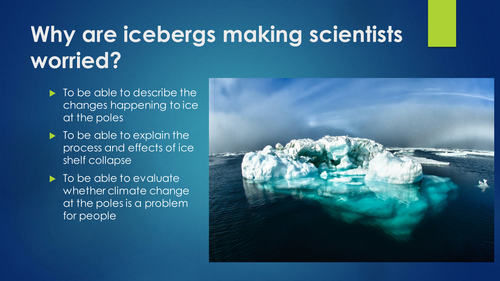






Lesson 10 - a lesson that considers why scientists are worried about icebergs. Students use a card sort / mystery type activity to find out what is happening to ice shelves and glaciers in Antarctica. They are asked to explain how ice shelves lead to sea level rise. The final task is to sort the advantages and disadvantages of ice melting and sea level rise.
This is a scheme of work about cold environments / polar places. It is designed to work in a completely mixed ability classroom and therefore is differentiated wherever necessary and includes challenge/extension questions. It includes the following topics:
- Where cold environments are and what they are like
- How people use cold environments
- What a glacier is and how it forms
- How glaciers change the landscape by creating corries, aretes and pyramidal peaks
- A comparison of the Arctic and Antarctic and why they are so cold
- Food chains, food webs and the wider importance of plankton at the bottom of the food chain
- Snowball earth and the idea of ice ages with varying amounts of ice on the planet
- The Antarctic treaty
- How cold places are changing, focusing on ice shelf collapse and sea level rise
This is a scheme of work about cold environments / polar places. It is designed to work in a completely mixed ability classroom and therefore is differentiated wherever necessary and includes challenge/extension questions. It includes the following topics:
- Where cold environments are and what they are like
- How people use cold environments
- What a glacier is and how it forms
- How glaciers change the landscape by creating corries, aretes and pyramidal peaks
- A comparison of the Arctic and Antarctic and why they are so cold
- Food chains, food webs and the wider importance of plankton at the bottom of the food chain
- Snowball earth and the idea of ice ages with varying amounts of ice on the planet
- The Antarctic treaty
- How cold places are changing, focusing on ice shelf collapse and sea level rise
Something went wrong, please try again later.
I thought this was a great resource thank you for sharing! My year 7s (EAL learners) enjoyed it!
Report this resourceto let us know if it violates our terms and conditions.
Our customer service team will review your report and will be in touch.
£0.00
